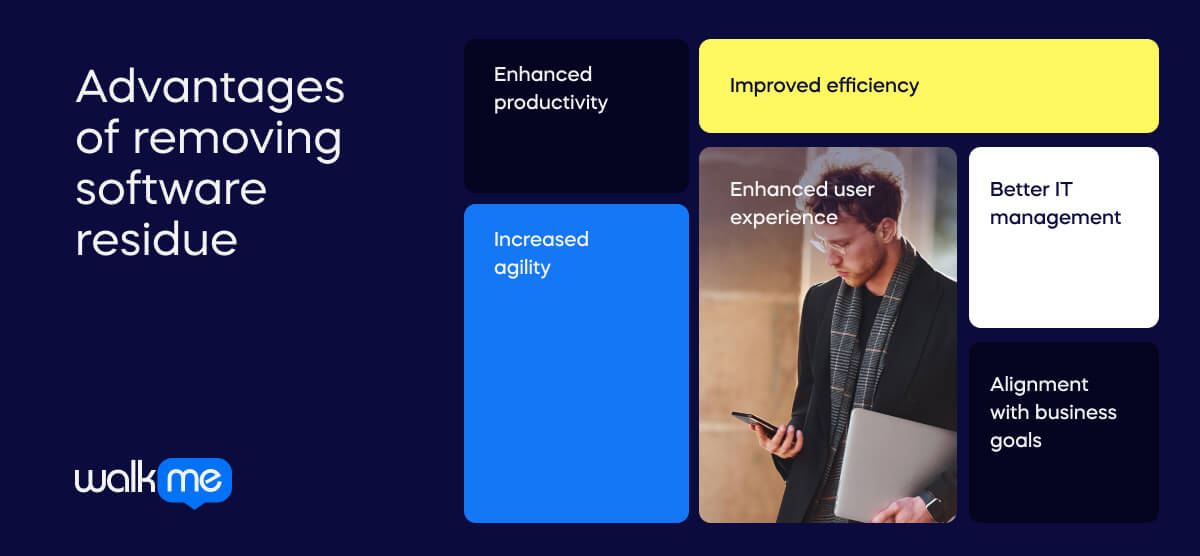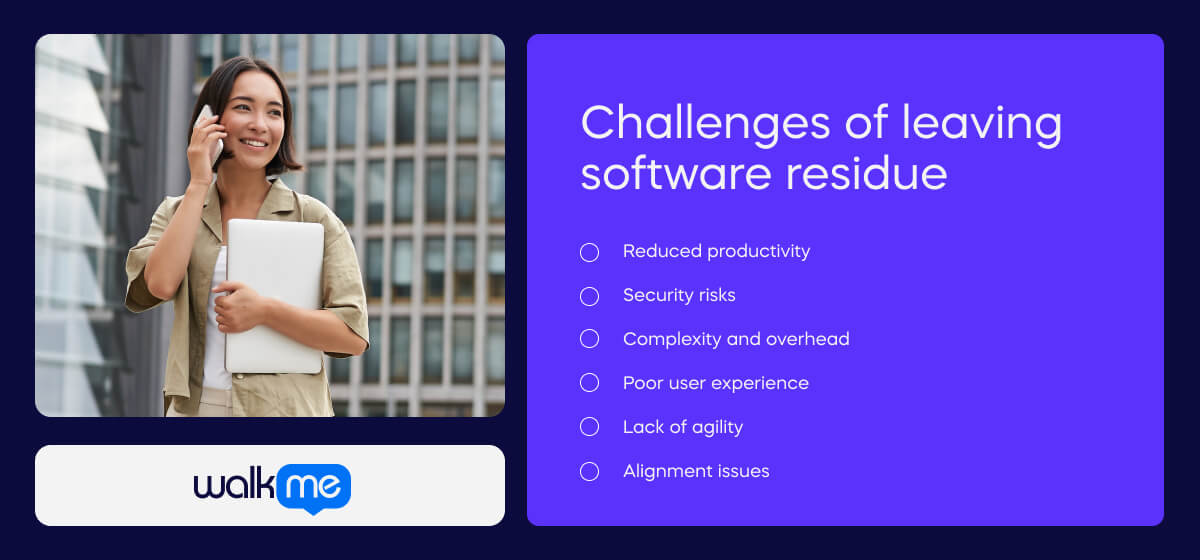What is software residue?

Table of contents
In the fast-paced landscape of digital transformation, software residue has emerged as a critical concept. Coined by WalkMe, software residue encapsulates the repercussions of hurried technology adoption during the COVID-19 pandemic and the shift to hybrid work models.
It represents a phenomenon where organizations embrace new technologies without thoroughly reassessing their existing systems. The consequence? A proliferation of redundant and overlapping applications undermines operational efficiency and digital progress.

According to WalkMe’s recent findings, a staggering 93% of enterprise leaders acknowledge the presence of software residue within their organizations. This recognition underscores the pervasive nature of the issue across industries and the urgent need for remedial action.
The impact of software residue extends beyond mere redundancy. In WalkMe’s State of Digital Adoption reports spanning 2022 to 2024, alarming trends have been uncovered. Previously, it was revealed that 27% of enterprise applications duplicated features found in other software solutions.
However, this figure has notably declined to 20%, indicating a positive shift towards reclaiming control over software stacks in the post-pandemic era.
Digging deeper into the data, it becomes apparent that the problem is more profound than initially perceived. Despite their scale and resources, large enterprises are only aware of 49% of their deployed applications. Moreover, they estimate that they are harnessing just half of the potential value offered by their software suite. This revelation highlights the discrepancy between software investment and its actual utilization, signaling a significant opportunity for optimization and streamlining.
Software residue represents a missed opportunity at its core—a manifestation of hasty decision-making and a lack of strategic foresight. In a rush to bridge technological gaps and adapt to evolving circumstances, organizations sacrificed thorough evaluation for expediency. Consequently, they find themselves burdened with a surplus of digital tools that fail to meet expectations and fall short of delivering tangible value.
Software residue serves as a cautionary tale, reminding organizations of the importance of deliberate, strategic digital adoption. By prioritizing thoughtful evaluation and alignment with organizational goals, businesses can mitigate the proliferation of redundant applications and unlock the full potential of their technological investments.
Why is it important to tackle software residue?
Software residue can have negative impacts such as:
- Wasting time and resources on maintaining and updating unnecessary applications
- Creating confusion and frustration among employees who have to switch between multiple tools
- Reducing the quality and consistency of data and workflows across different platforms
- Increasing the risk of security breaches and compliance issues due to outdated or unmanaged software
- Missing out on the full potential and value of the digital tools that matter
Therefore, tackling software residue and optimizing the software stack to align with the organization’s goals and needs is important.
This can help enterprises achieve the following:
- Greater agility and flexibility in adapting to changing market conditions and customer demands
- Higher employee engagement and satisfaction by providing them with the best tools for their tasks
- Improved collaboration and communication across teams and departments by streamlining the workflows and data
- Enhanced innovation and competitiveness by leveraging the latest and most relevant technologies
- Reduced costs and risks by eliminating unnecessary and outdated software
How can WalkMe tackle software residue?
WalkMe is uniquely equipped to expedite the removal of redundant software and streamline duplicate technology features.
Some of the specific WalkMe features that can help tackle software residue are:
- WalkMe Discovery: This feature provides visibility and insights into the software usage and performance across the organization. It can help to identify and highlight the applications that are not being used, underutilized, or duplicated. It can also recommend and facilitate removing or consolidating redundant or irrelevant software.
- Smart Walk-Thrus: These interactive step-by-step guides can help enhance the user experience and adoption of the deployed applications that add value. They can also drive new feature discovery and adoption with contextual guidance.
- ActionBot and resources: These features can help provide on-demand self-serve support and guidance to users without engaging the customer support team. They can also help streamline workflows and data across different platforms.
Use cases for software residue
Software residue in business
Software residue is a tangible challenge faced by businesses across industries.
Let’s explore real-world scenarios where software residue manifests and its detrimental impact on workplace efficiency and productivity:
Fragmented communication platforms: In many organizations, the proliferation of communication tools such as email, instant messaging apps, project management software, and collaboration platforms can lead to software residue. Employees may toggle between multiple applications to communicate with colleagues, resulting in fragmented conversations, missed messages, and decreased productivity. The lack of integration between these disparate tools can slow decision-making processes and hinder collaboration, ultimately impacting business outcomes.
Redundant software solutions: Another common scenario involves deploying redundant software solutions that duplicate features or serve overlapping purposes. For example, multiple departments within an organization may independently invest in customer relationship management (CRM) systems without coordination, resulting in data silos, inconsistent workflows, and wasted resources. The presence of redundant software complicates IT management and introduces unnecessary complexity into business operations, slowing down processes and impeding agility.
Legacy systems and shadow IT: Legacy systems and shadow IT—unauthorized software and applications used by employees without IT approval—can contribute to software residue in the workplace. Legacy systems, characterized by outdated technology and limited compatibility, often fail to integrate seamlessly with modern software solutions, leading to interoperability issues and process bottlenecks. Similarly, the proliferation of shadow IT can introduce security risks, data breaches, and compliance challenges, further exacerbating the problem of software residue.
Incomplete digital transformation initiatives: Incomplete or fragmented digital transformation initiatives can also cause software residue. Organizations may invest in new technologies or software platforms without fully retiring or optimizing existing systems, resulting in a hybrid environment plagued by redundancy and inefficiency. Without a cohesive strategy for digital adoption and software rationalization, businesses may struggle to realize the full potential of their investments and may experience friction in day-to-day operations.
Success stories: removing software residue
WalkMe Discovery has been of particular use in helping organizations remove duplicate or non-used applications, improving efficiency and cost-effectiveness across the business.
Here are two examples:
Nestlé: The global food and beverage company used WalkMe Discovery to gain visibility into their software usage and performance across 270,000+ team members.
They identified and eliminated over 100 applications that were not adding value to their business, saving them millions of dollars in licensing costs.
They also used WalkMe to drive adoption and engagement of their core applications, such as Microsoft Teams, SAP, and Workday, resulting in an estimated $30 million in productivity gains.
EDF Renewables: The renewable energy company used WalkMe Discovery to optimize their SAP ECC6 desktop application, which their technicians and employees employed in the field.
They discovered that the application had multiple elements that caused errors and confusion among the users, leading to low adoption and high support tickets.
They used WalkMe to simplify and streamline the application, removing unnecessary features and providing interactive guidance to users. This reduced the time to proficiency by 50%, increased user satisfaction by 80%, and decreased support tickets by 90%.
Software residue vs software leftovers
“Software residue” and “software leftovers” are two terms that are often used interchangeably. They can have different connotations and implications in digital adoption and technology management.
Let’s explore how the two differ:
| Software residue | Software leftovers | |
| Definition | Lingering effects of hurried tech adoption without reassessment of existing systems | Remnants of unused or underutilized software assets |
| Characteristics | Proliferation of redundant applications from rapid digital transformation | Accumulation of legacy applications, deprecated tools, or unused licenses |
| Impact | Impedes productivity, increases IT complexity, and hinders agility | Contributes to IT bloat, raises maintenance costs, and introduces security vulnerabilities |
| Examples | Overlapping communication tools, redundant software solutions | Legacy applications, unused licenses, deprecated tools |
| Resolution | Requires software rationalization, streamlined workflows, and strategic IT governance | Demands proactive measures like IT asset management and modernization efforts |
Advantages of removing software residue

Removing software residue offers numerous benefits, such as the following:
Enhanced productivity: By removing redundant and overlapping software, workflows become streamlined, reducing confusion and allowing employees to focus more on core tasks. This enhancement ultimately leads to increased productivity across the organization.
Improved efficiency: Rationalizing the software stack reduces the time spent navigating multiple tools, simplifies processes, and accelerates decision-making, leading to improved operational efficiency and faster task completion.
Enhanced user experience: A streamlined software environment provides employees access to the right tools at the right time, reducing frustration and increasing satisfaction with the overall user experience.
Better IT management: Removing software residue simplifies IT management by reducing the complexity of the IT infrastructure, minimizing security risks, and allowing IT teams to focus on strategic initiatives rather than maintenance tasks.
Increased agility: A leaner software stack improves organizational agility by facilitating faster adaptation to changing business needs, enabling quicker deployment of new technologies, and supporting innovation.
Alignment with business goals: Removing software residue ensures that the organization’s software investments align with business goals and priorities, allocating resources more effectively and driving value creation throughout the organization.
Challenges of leaving software residue

Here are the challenges associated with leaving software residue:
Reduced productivity: Leaving redundant and overlapping software in place can lead to confusion and inefficiencies, slowing down workflows and reducing overall productivity as employees navigate multiple tools to accomplish tasks.
Security risks: Outdated or underutilized software may pose security vulnerabilities, exposing the organization to potential cyber threats and data breaches. Unaddressed software residue increases the risk of security incidents and compromises sensitive information.
Complexity and overhead: A bloated software environment adds complexity to IT management, increasing the workload for IT teams and requiring additional resources for maintenance, troubleshooting, and support.
Poor user experience: Employees may experience frustration and dissatisfaction when faced with a cluttered and confusing software landscape, leading to decreased morale and engagement.
Lack of agility: An abundance of unnecessary software impedes the organization’s ability to adapt quickly to changing business needs and market conditions, hindering agility and innovation.
Alignment issues: Unchecked software residue may cause misalignment between software investments and business objectives, as resources are allocated inefficiently without a clear understanding of their value and relevance to the organization’s goals.
Removing software residue: A win for all
Software residue represents a significant hurdle to organizational efficiency, productivity, and agility.
By removing it, organizations can unlock many benefits that reshape operational dynamics and pave the way for success in the digital age.
Taking such steps is not just about tidying up the digital landscape—it’s about transforming processes, empowering employees, and driving innovation.
By embracing proactive measures to rationalize the software stack and optimize the digital ecosystem, organizations can position themselves for sustained success and thrive in an increasingly competitive and dynamic business environment.